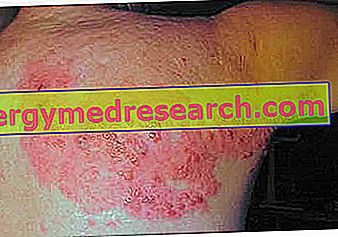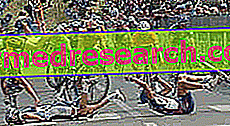Generality
" Fuoco di Sant'Antonio " is the popular name of the disease known as Herpes Zoster.
It is an infectious disease caused by the reactivation of the same virus that causes chickenpox: the Varicella-Zoster Virus (VZV).

Causes
The first time the body is infected with this virus, it develops a disease known as chicken pox, very common in children.
After the resolution of the primary infection, the virus remains in the body in a quiescent state, finding shelter from the immune defenses in the nerves.
During the course of life, the latent infection with VZV can be reactivated, causing a disease known as the Fire of St. Anthony or Herpes Zoster.
Old age, stress and any other factor that can reduce the body's immune defenses are the main risk factors for virus reactivation.
Symptoms and Complications
The shingles fire causes rashes characterized by the appearance of red spots, which evolve into blisters or bubbles. The affected area (usually the trunk, more rarely the face) is painful, often itchy.
Sometimes the pain starts before the spots appear.
If the face is also involved, especially in the eye area, the disease is called herpez zoster ophthalmic; in these cases it is important to immediately contact the doctor to receive the appropriate treatment, given that in the absence of treatment the eyesight can suffer serious repercussions.
Sometimes the pain remains for several months after the resolution of the skin lesions; in these cases we speak of post-herpetic neuralgia, a serious, debilitating and difficult to treat complication.
Treatment and Vaccine
The treatment of Herpes Zoster uses analgesic and anti-inflammatory drugs. The early administration of antiviral drugs is able to decrease the severity and duration of symptoms.
For those at risk, a vaccine is available to prevent the appearance of St. Anthony's Fire, and its complications, in over half of the vaccinated subjects.
Why do you call it that
Saint Anthony is known as the patron saint of fire, the fire that recalls the itching and burning burning sensation, typical of the infectious disease of the same name.
Causes and Contagion
Primary infection

This disease is characterized by the appearance of numerous red spots appearing on the skin and rapidly evolving into vesicles (see figure).
More rarely, primary infection occurs asymptomatically.
Latent infection and reactivation
After primary contact with the varicella zoster virus, the immune system is mobilized to neutralize the virus, producing specific antibodies.
These antibodies become part of the human immune system, preventing subsequent infections.
Despite the presence of numerous antibodies, the organism cannot completely defeat the herpes zoster, which withdraws taking refuge in the sensory ganglia of the dorsal roots of the spinal cord and / or of the cranial nerves. Here, the virus remains silent for a long time, sometimes for life.
Thus we enter a latent phase, in which the virus is incapable of multiplying and remains in ambush waiting for the immune defenses to subside.
This protection can fail for:
- intensive exposure to sunlight;
- drop in immune defenses related to old age, diseases (AIDS), or prolonged use of some drugs (corticosteroids and especially immunosuppressants);
- severe psychophysical stress.
Epidemiology and Risk Factors
About 90-95% of people get varicella during their lives and it is estimated that, of these, about 10-20% is subsequently hit by the Saint Anthony fire. In Italy there are about 150, 000 new cases of Herpes Zoster per year.
- Although it can occur at any age, Herpes Zoster is a disease typical of elderly people
- In the United States, it affects 0.2-0.3% of the general population every year, while the annual incidence in the over-75s is close to 1.5%
- 2/3 of the cases of Herpes Zoster occur in people over 50 years of age.
- Advanced age is therefore considered the first risk factor for the reactivation of Varicella Zoster Virus.
In general, those who have never had Varicella will never have St. Anthony's fire, while all those who have suffered it run the risk, albeit moderate, of going against future episodes of varicella-zoster virus reactivation .
Shingles frequently arise in the elderly and in people with diseases of the immune system or undergoing treatment, such as chemotherapy and radiotherapy, which damage, even if in a transient way, the defense mechanisms against infections.
Other times, however, the disease manifests itself in completely healthy people who, due to trivial facts such as stress, cold or sunburn, become weaker and become more susceptible to becoming ill.

Risk after a first episode
The likelihood of undergoing a second reactivation of the varicella zoster virus is similar to that of the first; consequently, having already developed St. Anthony's fire does not protect in any way from subsequent reactivations.
Is it contagious?
A person with Herpes Zoster can transmit the infection only to individuals who have never had their primary infection (chickenpox) and who have not been vaccinated for this disease. Clearly, in the event of contagion, these individuals will not develop St. Anthony's Fire, but rather chickenpox.
New exposure to the virus has not been shown to cause varicella zoster virus reactivation. Therefore, there is no risk of "contagion" between individuals already affected by chicken pox.
Symptoms
To learn more: Fire symptoms of St. Anthony
St Anthony's fire is characterized by the appearance of a painful cutaneous rash, characterized by numerous red, flat or raised spots, which rapidly develop into vesicles.
These vesicles continue to form for 3-5 days, after which they tend to evolve into pustules (filling with pus) and crusts.
The formation and rupture of vesicles coincides with the peak of contagiousness of the disease, while patients stop transmitting the virus when all the lesions have dried and crusts have formed.
Prodromal phase
The appearance of the vent is often preceded by a so-called prodromal phase, characterized by reddening of the skin and a sense of tingling or numbness in the area in which the vesicles will appear. In general, this "anticipatory" phase precedes the eruption by 48 to 72 hours, but can begin up to two weeks before the appearance of the lesions.
Shingles can cause localized and severe abdominal pain in the absence of typical skin lesions, which develop only a few days after the onset of pain.
Location of Injuries
In 50-60% of cases, the lesions of the Fire of Saint Anthony are located in the thoracic area, along the coasts.
The manifestations can however also appear in other zones, variable from subject to subject, given that the typical vesicles tend to appear along the course of the nervous branch in which the shingles had taken refuge.
For example, when the trigeminal nerve is affected, the lesions may appear at the level of the face, mouth, tongue or eye.
This manifestation - called ophthalmic zoster - occurs in 10-20% of patients with shingles.
To know more:
- Symptoms Herpes zoster ophthalmic
Pain and Other Symptoms
The eruption, often very painful, is sometimes accompanied by fever, a sense of general malaise, chills, headaches and stomach pain.
From the clinical point of view, the main manifestation of herpes zoster is pain, which generally appears in the prodromal phase, is maintained during the eruptive phase and, at times, remains for long periods even after the resolution of the vent. It is often associated with itching and local tingling.
The pain associated with herpes zoster is very often of moderate-severe intensity and presents itself with characteristics that vary from individual to individual; many patients describe it as a throbbing, acute, burning (burning) pain, stabbing or stabbing, as if a needle pierced the skin.
Sometimes the vesicular rash of shingles may cause severe pain localized in the left side of the chest, simulating a pain of cardiac origin.
Headaches, light intolerance and, rarely, fever may also be present.
In some cases, quite rare, the infection of the motor neurons in the anterior horns of the spinal cord can cause a motor paralysis in the area of distribution of the affected nerves.
Resolution
Within 7-10 days of their appearance, the vesicles break and form scabs.
Once formed, the scabs tend to spontaneous desquamation over 10 days. The skin usually returns intact over the following 2-4 weeks; there are often slight scars and changes in skin pigmentation.
Photo

Clinical manifestations of shingles at shoulder and back level

See other Photos of the Fire of Saint Anthony
Complications
Postherpetic neuralgia is the most common complication of Herpes Zoster. It is a chronic neuropathic pain that develops at least 30 days after healing of the skin lesions and can continue for months or years. Once again, the elderly are the most affected by this complication.
For further information:
- Post-herpetic neuralgia
In the absence of therapy, eye involvement ( herpes zoster ophthalmic ) can lead to blindness. In fact, it has been calculated that a percentage of 50-72% of these patients is affected by an eye pathology, such as keratitis, which can develop into corneal ulceration or acute retinal necrosis.
Other complications of Herpes Zoster - more likely in immunocompromised individuals - are pulmonary infection and involvement of the central nervous system, which may be responsible for myelitis, aseptic meningitis and meningoencephalitis.
Increased Risk of Stroke
Recent epidemiological evidence has linked Herpes Zoster with a significant increase in the risk of Stroke (+ 30% ca) in the following 6-12 months.
This risk would be greater for patients suffering from Herpes Zoster ophthalmic, in whom the risk at one year would have increased by 3-5 times compared to the controls.
Treatment
The treatment of herpes zoster has the primary objective of reducing pain, through the use of anti-inflammatory and analgesic drugs.
Skin lesions must be kept clean and dry to avoid overlapping of bacterial superinfections of the skin. Any bandage must be soft (non-adherent) and is indicated to protect injuries from contact with clothing.
Specific antiviral drugs (acyclovir, valaciclovir, famciclovir) help to limit the severity and duration of herpes zoster, provided they are taken within the first 48-72 hours after the onset of the eruption.
To know more:
- Herpes Zoster treatment medications
For those affected by post-herpetic neuralgia, the treatment corresponds to that of neuropathic pain: antidepressants (eg amitriptyline, nortriptyline, imipramine), antiepileptics (eg gabapentin, pregabalin), opioids (eg oxycodone, codeine, can be used) morphine, fentanyl, buprenorphine), neuroleptics and topical agents (eg lidocaine and capsaicin patches).
To know more:
- Drugs for the treatment of post-herpetic neuralgia
See also:
- Diet for Saint Anthony's Fire
Vaccination
For individuals at high risk of shingles or those subject to recurrence, a specific vaccine has been developed for the prevention of Herpes Zoster and Post-Herpetic Neuralgia, marketed under the registered name Zostavax ®.
In a study conducted on 38, 000 adults aged 60 or over, this vaccine reduced the incidence of the disease by 51.3%, lowering the cases of post-herpetic neuralgia by 66.5%.
To know more:
- Zostavax - Vaccine Fire of Saint Anthony



